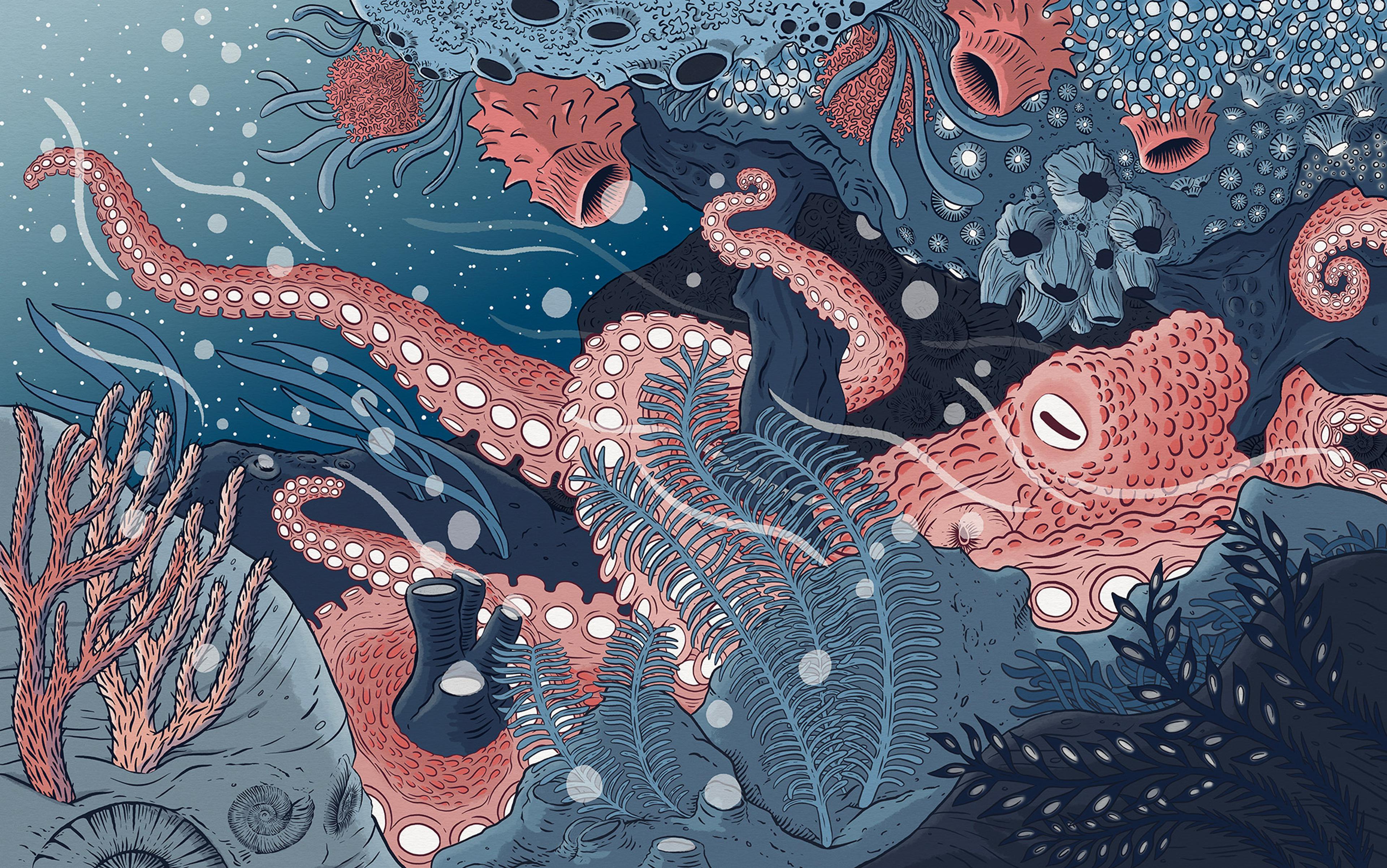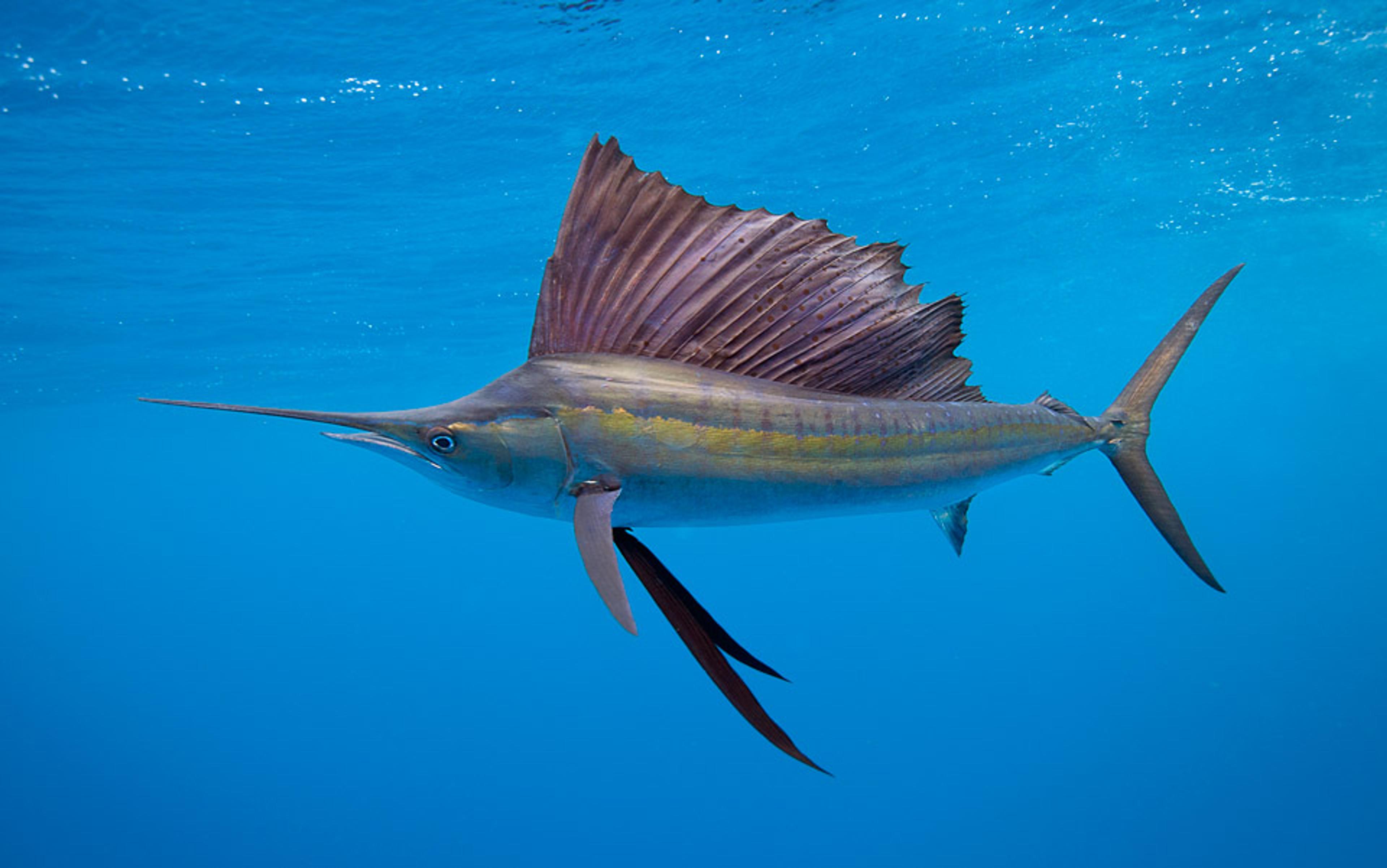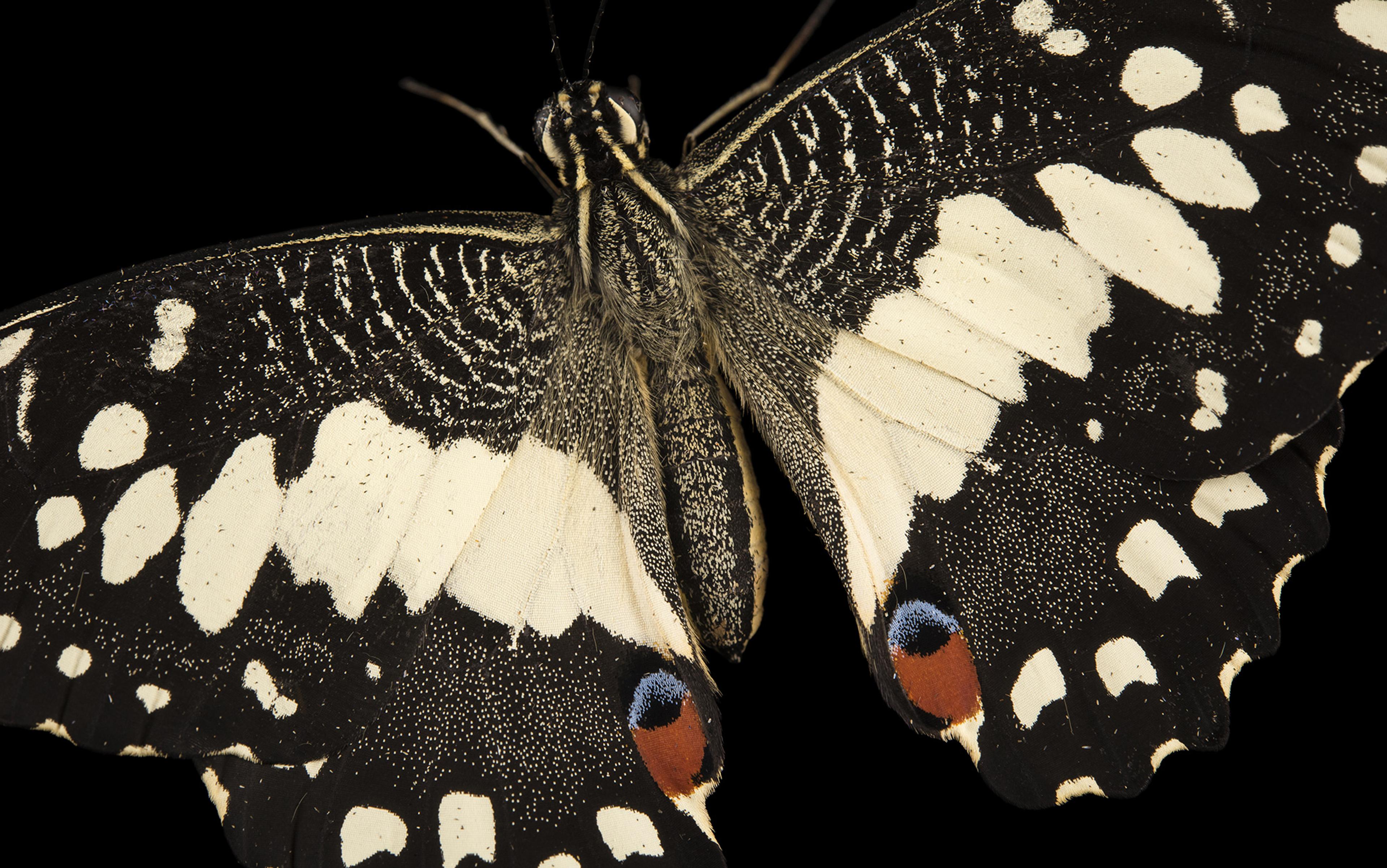Light spatters on the seafloor, creating a moving kaleidoscope of greens, blues and beiges as seagrass sways back and forth in the current. Shoals of fish shimmer in and out of rock formations while rays fly above, casting their shadows over crabs trawling the mudflats for edible detritus. And surveying it all through two oblong eyes, the octopus glides in the open water like a frictionless spaceship. As an eight-armed cephalopod, it neither looks nor moves like its aquatic peers. Up, down, left, right, forward or backward – all are accessible to the octopus. And though elegance and structural integrity are often inseparable in nature, the octopus can break its streamlined form at any moment, splaying its body and collapsing onto (or into) the rocks below. From the refuge of a rocky crevice, it watches and waits patiently. When prey passes, it may shoot out an arm or two to encircle an unlucky passing shrimp; or it may erupt from cover, lunging its entire body wide like a net cast by a fisherman.
The octopus may navigate its ocean home with ease, but it can seem like a creature from another planet. It populates our popular visions of cosmic beings and extraterrestrial life, with its eight arms, three hearts, and a malleable body without bones. What’s more, its ability to camouflage itself, coupled with a propensity to hide in tight holes, make it a master of disguise. If seen, a water siphon that expels inhaled water can instantly propel the creature away from danger in any direction in three-dimensional aquatic space. Its web of radially symmetrical arms allow it to crawl in any direction with equal competence, regardless of how its head is oriented. Its soft and malleable body can move through any crevasse larger than its beak. And with its two eyes positioned on opposite sides of its head, it has a near-total field of vision with almost nothing hidden ‘behind’. These abilities give the octopus a radically different relationship to its surroundings compared with other species, human or otherwise. It is a relationship free of constraints.
And what about our bodies? Compared with the octopus, human beings appear corporeally constrained. We lack the fluid mobility and wide field of vision of our (very, very) distant cephalopod cousins. Instead, we have two eyes stuck in the front of our heads. We have a paltry two legs, hardwired for forward movement. And we are bound to our terrestrial ecological niche, where our bodies must continually counteract the downward pull of gravity.
It’s not only that our experiences of space are different. Our experiences of time are likely different, too. We think about the passage of time through our terrestrial experience of unidirectional motion through space – our metaphors of time are almost all grounded in the way our bodies move forward through the environment. Given this fact, how would an octopus, who can easily see and move in all directions, conceptualise time? Current research methods may be able to take us only part of the way toward an answer, but it’s far enough to consider a radical possibility: if we became more like an octopus, could we free time, metaphorically speaking, from its constraints? Could we experience it as multidimensional, fluid and free?
Research from linguistics demonstrates that the metaphors humans use to speak about time are profoundly embodied. Human bodies are directional, meaning our physiology has a direction: it faces forwards. Consider the positioning of our eyes or limbs, which are all oriented toward one direction. This embodied reality means that we are more capable of moving and acting on objects in front of us than behind. We also think about time in a similar way. Consider expressions like ‘we are going into the weekend’ or ‘we’ve left the past behind’. In both sayings, we move forward into the future and away from the past. These are examples of what is known as the ‘ego-moving’ metaphor, in which time is construed as unidirectional, with the future in front of us and the past behind us. This metaphor influences the more abstract idea that we can act only on events in the future, not the past. Just as it is physically impossible to manipulate objects placed a metre behind your back, it is also impossible – according to the ego-moving metaphor – to manipulate events that occurred yesterday.
Another common way of thinking and speaking about time is the ‘time-moving’ metaphor. In this metaphor, we remain stationary while time flows through us. Expressions derived from this metaphor include ‘let’s get together this coming Friday’ or ‘my vacation flew by’. In these expressions, the future is conceptualised as something that flows through us, as opposed to something we actively move towards.
Individuals born blind do not exhibit evidence of a front-to-back representation of time
Certain factors can influence which of the two metaphors we are more likely to use. In one study, researchers developed an ambiguous question about time that could be answered from either an ego-moving or time-moving perspective:
Next Wednesday’s meeting has been moved forward two days. What day is the meeting now that it has been rescheduled?
From the ego-moving perspective, Wednesday’s meeting has been rescheduled to Friday. From the time-moving perspective, it has been rescheduled to Monday. The researchers then asked this question to people standing in a 10-minute-long lunch queue, and found that those further back in the line were more likely to adopt the time-moving perspective, while those near the front of the line, and closer to the food, favoured the ego-moving perspective. In other words, the more forward motion a person experienced, the more likely they were to think of themselves as moving through time.
What we can learn from this is that our experience of time is deeply embodied, but also somewhat flexible: whether we use the ego-moving or time-moving metaphor depends on how we move through the space around us. And this flexibility is not just related to how we move; it’s also about how we perceive the world. Individuals who are born blind do not exhibit behavioural evidence of a front-to-back representation of time, which suggests that vision-dependent embodied interactions in the world are crucial for grounding time along the front-to-back axis.
Context is important, too. In China, people favour the time-moving perspective because Chinese culture places greater emphasis on the collective rather than the individual, making ego-driven metaphors less common. The adoption of the time-moving metaphor in China, as the applied linguist Ning Yu claims, is likely grounded in the cultural importance of the Yangtze River, which provides a physical model for the slow but persistent flow of matter (rather than of individuals moving through time).
While the exact mechanisms for the adoption of ego-moving or time-moving metaphors remain to be determined, one thing is clear: our metaphors for time are not fixed. They emerge through our embodied interactions with our surroundings as well as our cultural contexts. However, even though there is some flexibility in our conceptions of time, the fundamental unidirectional structure of time-metaphors remains the same. In almost all our metaphors, time is bound to a single direction, much like how our bodies work, with eyes and legs that draw us forward, never behind.
The octopus doesn’t have eyes or legs that preference forward motion. Instead, its body allows movement in any direction, which is a relatively unique adaptation within the animal kingdom. The octopus has been the subject of intense scientific research, much of which has focused on the creature’s remarkable intelligence. Studies have demonstrated exceptional learning, memory, problem-solving and recognition abilities, making octopuses and closely related cephalopods like the cuttlefish credible candidates for animal sentience. Octopus intelligence is an example of convergent evolution, meaning it shares striking similarities with human intelligence yet the two evolved completely independently from each other. Our shared ancestor is a flatworm that lived on the sea floor some 600 million years ago with nowhere near the neural complexity observed in either creature today. Scientists studying octopus intelligence have largely approached the problem by asking which aspects of human intelligence the creature can replicate. But perhaps this approach is misguided. Instead of asking whether an octopus shows aspects of human intelligence, perhaps the better question is whether humans can show aspects of octopus intelligence.
This question takes on particular significance when considering how the octopus thinks about time. And there is good reason to believe that an octopus thinks about time. For a start, we can infer that the octopus mentally travels back and forward in time based on observations of how it behaves. ‘Mental time-travel’ refers to the cognitive ability to travel ‘back’ by recalling past experiences or ‘forward’ to simulating future scenarios. Evidence of the octopus mentally travelling back in time are observed when it temporarily avoids returning to the same location of a recently successful hunt. The octopus knows that if a clam was scraped off a particular rock, or a crab pulled from a particular crevasse, another would likely not reappear in the same spot for at least a short period of time, and therefore that location should be avoided. Another example can be seen when the octopus catches prey. If it successfully catches prey at a particular location, the distance to its den is a significant predictor of whether it will choose to consume the catch in a nearby hiding place or instead return to its den. As an octopus gets further away from home, the likelihood increases that it will consume its meal before returning. It is mentally ‘travelling back’ in time before making careful judgments about what it should do.
When threatened, it assembles the coconut halves into a makeshift shelter to protect itself from attacks
More evidence that the octopus can mentally ‘travel back’ in time comes from observations of its navigational abilities. If a strong current pulls an octopus far beyond the view of its den, it can still navigate home, presumably by noticing features of the landscape (eg, big rocks, seaweed patches) and relating them to previous experiences in order to construct a cognitive map. This is like getting lost while driving and not having a phone or a GPS device. If you take a wrong turn, you will scan your surroundings in search of familiar landmarks, like a recognisable building or an elevated freeway. Once spotted, you can then build a cognitive map of where you are relative to your destination, if you know where your destination is relative to the landmark. The fact that the octopus can do the same suggests an ability to think about past events.
There is also evidence that octopuses can think about the future. Amphioctopus marginatus, a soft-bodied octopus species found in tropical waters of Indonesia, has been observed carrying coconuts halves as it moves along exposed sections of the seafloor. When threatened, this species will assemble the halves in the form of a makeshift shelter to protect itself from attacks – a coconut fortress in a landscape that offers little in the way of cover. This behaviour is remarkable for two reasons. First, it shows tool use, which is a benchmark for cognitive sophistication. And second, it suggests that the octopus can mentally ‘travel forward’ to simulate future scenarios, such as the potential for future predation in exposed sections of the seafloor. As an analogy, we wear seatbelts not because a car accident is currently happening, but because we can mentally ‘travel forward’ to simulate the possibility of a car accident happening, which is why we take protective measures in the present.
Taken together, these pieces of evidence strongly suggest that the octopus can mentally represent time. But how might the octopus structure its representation of time?
If embodied interactions with our surroundings ground human metaphors for time, one can only imagine the metaphors an octopus might use. Given it has equal competence interacting with objects behind or in front of its body, past events could be, metaphorically speaking, just as manipulable as future ones. Expressions like ‘let’s put the past behind us’ would be meaningless for the octopus. Moreover, given the octopus can change its visual perspective of its surroundings by swimming upward, all events in time – the past, present and future – could be surveyed from one metaphorical wide-view vantage point, allowing for the identification of patterns in events that occur across long periods time.
If humans were to adopt octopus-inspired metaphors for time, our relationship to our personal past might become more meaningful. It would allow our past to be causally linked to the present. It might allow our attention to shift away from the culturally conditioned obsession with future-focused progress. It might allow historical ideas to be excavated and used as sources of innovation for everything from medicine to politics. And it might allow a more expansive conceptualisation of events that can be considered meaningful, all due to metaphors of time that are free from constraints.
One way of considering how this might be possible is through research on the narratives we form about our lives. According to narrative psychologists, a stable sense of self depends on a unified narrative that structures life experiences into a coherent story, connected in time. Traumatic experiences can rupture a narrative, resulting in dissociative identity disorder in which a person adopts a different personality altogether following an experience that is too difficult to integrate. Treatment for dissociative identity disorder involves flexibly moving through the past and future – analogous to how the octopus moves through space – to first rebuild the individual’s disrupted past sense of self, and then shift focus toward a desired future self.
Cultural theorists have written about dissociative identity disorder scaling up to the level of society, following periods of mass trauma such as war. In 1945, Carl Jung wrote that the central task of the German people was to confront the collective guilt associated with the atrocities their country had just committed during the Second World War in order to move forward, towards a more liberal future. Similarly, in the modern-day United States, writers like Ta-Nehisi Coates lay bare historic injustices committed against African Americans, arguing that the only way the country can address racial inequality now and move forward is to acknowledge and repair past wrongs.
In the Aymara language, spoken in Peru, tomorrow is called q’ipi uru (‘the day at my back’)
Through a more octopus-like unconstrained view of time, past successes can be excavated as sources of innovation, too. Modern democracy itself, first piloted by France and the US near the end of the 18th century, was a resurrection of an idea invented by the ancient Greeks more than 2,000 years prior. Moreover, conceptualising past events as meaningful objects to interact with would allow our attention to shift away from the culturally conditioned obsession with progress, which writers like Byung-Chul Han have argued is at the root of damaging experiences of widespread burnout. Of course, none of this is to say we shouldn’t also attend to the present; even the octopus does so when waiting patiently to strike at passing prey. But it does highlight the need for a more expansive conceptualisation of events across time – and new metaphors that might free time from its constraints.
This thought experiment may seem like wild speculation, or wishful thinking. An impossible chasm appears to open between the human and the octopus. However, an analysis of lesser-known metaphors for time in different human cultures reveals that there are already ways of thinking about our embodied experience that come a little closer to the uninhibited movement of the octopus. In the Aymara language, spoken in Peru, the past is described as nayra timpu (‘the time before my eyes’), and tomorrow is called q’ipi uru (‘the day at my back’). This metaphor is grounded in the fact that past events are known (visible) and can be discussed, whereas the future is unknown (not visible).
A different, complex metaphor for time is found in the Toba language, which is spoken in regions of Bolivia and Paraguay. In this language, time moves in a circle that metaphorically travels counterclockwise around a person, passing from front to back. In Toba, the recent present is conceived as being immediately in front of someone, which arcs up above their head to the remote past and passes right behind them to the remote future. The expression so (‘moving out of view’) is used to indicate the recent past, while the word ka (‘remote’ or ‘out of view’) indicates both the distant past and the distant future, neither of which can be ‘perceived’ visually.
What is consistent across the Aymara and Toba languages is an acknowledgment that the past remains an object that can be interacted with, as it would be in an octopus-inspired metaphor of time – octopus time may not so be unthinkable after all. However, before we get ahead of ourselves, we need to acknowledge the one domain where human and octopus experiences of time may be truly incommensurable.
While there is some diversity in human metaphors for time, there is one temporal experience that is shared across the members of our species: finitude. All humans eventually die, and we have developed a rich selection of metaphors about death that fit with our embodied conceptualisations of time. Sometimes, these metaphors are subtle and inconspicuous. Take the word ‘finitude’ itself, which comes from the Latin word finitūdō, referring to a ‘state of being finite’ or ‘limitedness’. These are both spatial concepts that find expression through metaphors in which death is understood as an absence of motion, such as saying that someone has ‘hit a dead end’ or ‘ran out of gas’.
As in our metaphors for time, our metaphors for death also rely on our bodily experiences. Expressions like ‘he keeled over’ or ‘she’s resting in peace’ use our experiences of standing upright or wakefulness as counterpoints against which to generate meaning. And, as the ego-moving metaphor would predict, death is something we ‘face’ in front of us (as opposed to something we ‘back’). Space, motion and the body play prominent roles in structuring our metaphors for death, so what metaphors might an octopus – with an embodied reality radically free of constraints – generate to structure its representation of death?
Like humans, the octopus’s time on Earth is also limited. However, its death comes quickly. Most species live no longer than about three years in the wild. Death also arrives on different terms for the octopus. Most octopus species are semelparous, meaning they reproduce only once in their lifetime and die shortly after. For the female, birth seems to trigger internal chemical changes that begin to degrade the tissue in her body, giving her just enough time to brood her eggs before dying. And she does so with an existential commitment, never leaving her den to feed herself. Instead, she focuses her attention on the eggs, protecting them from predators and passing water over them to keep them oxygenated. As time passes, her skin begins to lose colour and degrade, she loses weight, and her muscles become weaker. She dies about five months after giving birth, having rarely left her eggs, even to eat. The male has already died. His life ended only a few short weeks after mating.
The octopus invites us to think in a way that dissolves the boundaries between present and future
A plausible explanation for semelparity is that the adults will out-compete their young in the acquisition of resources in their environments, stunting their development or even starving them to death. Even worse, octopuses are literal cannibals, and bigger ones will prey on smaller ones, including their own young. Every creature faces trade-offs in pursuit of its multiple goals. In the case of the octopus, life itself is traded off to increase the chances of survival of the next generation. It’s no surprise, then, that the creature expends every last ounce of energy on her brood, producing eggs for her one and only hatch that will number in the hundreds of thousands, similar to other semelparous organisms like salmon and cicadas.
The semelparous octopus presents a relationship with death, and time, that is profoundly different from ours. As humans, we do not approach mating or childcare with the expectation that death will soon follow. We imagine our lives continuing past those events. The octopus sacrifices its own future for the future of its offspring. It becomes part of a process of intergenerational labour, which required the death of its parents and will someday require the death of its children. Through its death, the octopus submits itself to this labour, which it will never see completed. As a poetic interpretation, it’s as if death for the octopus is conceptualised as less rigid. Death is not a ‘dead end’, as we imagine it, but part of a more fluid process that stretches across generations.
Unlike our speculations about time, we will never really know how the octopus conceptualises death. But its physical reality, one of profound fluidity in life and death, can still be used to ground new human metaphors. Speaking of time as cyclical, where the past repeats itself in the future, has been shown to reduce estimations of the length of grief following a death in the family. Similarly, some patients in end-of-life care speak of shifting from ego-moving to time-moving metaphors, allowing them to conceptualise the passage of time as less fixed and more fluid. After this shift, they report a newfound ability to receive the help that is offered to them by their caretakers.
In many ways, the octopus represents a challenge, or a profound limit, to our conventional ways of thinking about time and death. But it’s more than a challenge. It’s also an invitation. With its unconstrained movements and semelparous lifecycle, the octopus offers a radically different perspective on the fluidity and flexibility of existence. Could we learn to move through time as an octopus moves through space? With equal access to the past, present and future – viewed wide or with sharp focus – we might better navigate the challenges of living and dying on Earth. The octopus invites us to think in a way that dissolves the boundaries between the present and the future, understanding our ‘ending’ less as a fixed point and more as a fluid process stretching across generations. As the boundary between life and death dissolves and becomes more porous, so do the boundaries between ourselves and others. The metaphors we used to inhabit our time here may seem impoverished, but there’s another way. It’s in the unconstrained movements of an octopus travelling through space – fluid, flexible and free.






